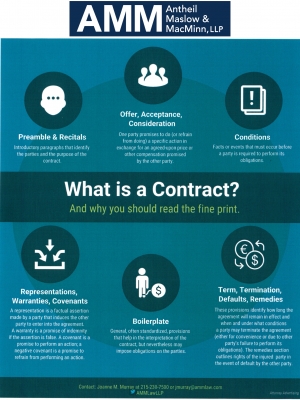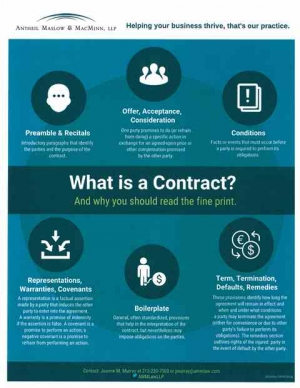What is a Contract: Part 4: Representations, Warranties, Covenants - The Bones of the Agreement.
This is the fourth installment of my continuing blog series explaining the main elements of a contract, which are outlined on the attached infographic . My goal is to demystify some of these basic provisions to help business owners have a better general understanding of what they are signing.
This article discusses representations, warranties, and covenants, which are the “bones” of the parties’ agreement. These provisions represent the statements of the underlying facts, mutual assurances, and promises of performance which form the basis of the parties’ mutual understanding. It’s not uncommon to find these concepts used interchangeably in a contract – “ABC represents, warrants, and covenants…”, but the meaning and effect of each of these are quite distinct from one another. It’s important to understand these distinctions so that your contracts accurately reflect the assumptions, obligations, and risks that you are comfortable with.
A representation is a statement of past or present fact (either express or implied) made by one party to induce the other party to enter into the agreement. For example, the seller of a business might represent that gross revenues from the business were a certain dollar amount for the past several years or that there are no claims asserted against the business. If a representation proves to have been untrue when made, the injured party will have a claim of fraudulent misrepresentation if she can prove that: (i) the party making the representation knew or should have known the statement was false when made; (ii) the other party intended the injured party to rely on the statement; and (iii) the injured party’s reliance on the statement in entering into the agreement was justifiable. The injured party can seek monetary damages for its losses or it may ask the court to rescind (void) the entire contract. It is therefore very important to avoid “over-representing” in your contracts.
A warranty is essentially a promise that an assertion made by a party is true, coupled with an implied promise of indemnity if the assertion made by the party is false. As such, a warranty is both present-focused, like a representation, and forward-looking, like a covenant. If a warranty is breached, the injured party is entitled to be made whole; this usually means that the injured party can recover the difference between the value of the contract as agreed upon and the value of the contract in light of the breach. In other words, the injured party is entitled to receive the benefit of the bargain he initially made. The injured party is not required to demonstrate that he relied on the warranty or that the other party knew that the warranty was false when made.
Often, but not always, representations and warranties go hand-in-hand to allow the parties to preserve remedies that are as broad as possible. In complex agreements, the parties usually spend a significant amount of time negotiating how the risks embodied by representations and warranties should be allocated by qualifying and limiting these concepts (e.g., a representation is true to the best of the maker’s knowledge and/or in all material respects).
Product and service warranties are specialized contractual provisions that are actually hybrids of representations, warranties, and covenants. These provisions commonly create limited express warranties that apply to the products or services, identify specific contractual remedies for breach, and disclaim implied warranties that are provided by law.
A covenant is a party’s promise to perform an action or to refrain from performing an action. It relates to the future, as opposed to representations, which are provided as of a specific date. An example of a covenant is a borrower’s promise to make loan payments in accordance with the terms of a promissory note. Covenants can be express or implied. Pennsylvania law imposes an implied covenant of good faith and fair dealing in most contracts.
Stay tuned for Part 5 of this series, which will move on to discuss some possible hidden perils of what is commonly dismissed as “just boilerplate” language.
What is a Contract: Part 3: Conditions - When Is a Promise No Longer a Promise?
This post continues my series explaining the main elements of a contract, which are outlined on the attached infographic. My goal is to demystify some of these basic provisions to help business owners have a better general understanding of what they are signing.
Another key element of a typical contract is a condition. A condition is an event that must occur or a fact that must be true before a party is obligated to perform his obligations under a contract. Conditions are used to allocate risk by making a party’s obligations, which would otherwise be absolute, dependent on circumstances that are usually outside of that party’s control. The risk of those circumstances not occurring is thus shifted to the other party. For example, your agreement to buy a parcel of real estate might be conditioned on your ability to obtain financing. If you are unable to get financing, you are not obligated to proceed with the sale. Your failure to perform your obligations is excused and is not a breach; the seller will have no claim for damages against you based on your failure to perform. A condition is not necessarily tied to a third party’s performance of an action (such as a bank agreeing to lend money to the buyer) but is sometimes linked to the performance of an obligation by the other party. Some conditions are dependent on weather or similar events that are altogether outside of the contracting parties’ and third parties’ control.
Sometimes a condition is drafted so that its non-fulfillment excuses some, but not all, of a party’s obligations under the agreement. As a result, if the condition is not met, the agreement remains in force as to all other obligations. On the other hand, a condition may be drafted so that the entire agreement will terminate if the condition is not satisfied (such as the property sale example above). It is important to note that the party benefitting from the condition may choose to waive the condition and proceed with performance under the agreement. Further, if the party whose obligations are conditioned performs those obligations even though the condition has not been satisfied, he may be deemed to have waived the condition.
Conditions are not necessarily identified in a single specific section of a contract, but often are sprinkled throughout the agreement where the parties’ obligations are identified. Because of the impact of an unsatisfied condition, it is important to be able to recognize conditions on the other party’s obligations before you enter into the agreement. Look for words such as “if”, “provided that”, “in the event that”, “subject to”, “on the condition that”, “conditioned on”, and “contingent on”.
Before you sign any contract, you should be sure to assess whether any of your obligations should be conditioned on the occurrence of facts or events. If so, it is important that those conditions be clearly identified. Similarly, you should review the agreement to identify any conditions to the other party’s obligations and their impact on the agreement overall and your rights under the agreement. Ask yourself:
• Does the agreement set out unrealistic, vague or unpredictable conditions under which the other party could be released from its contractual obligations to me? Will I have incurred unnecessary expenses prior to the determination whether the condition has been satisfied (e.g., purchase of supplies or services)?
What impact will a release of the other party’s obligations have on my business (e.g., finding a substitute vendor)?
• What actions or omissions (by me or key staff) could result in a release of the other parties’ contractual obligations?
• Are any conditions on my performance needed to provide a way out in the case of prohibitive or unacceptable changes in circumstances down the line?
In summary, contractual agreements will ultimately only yield the intended benefits to your business if they are enforceable, and that means understanding under what conditions some or all of the other party’s obligations might be excused.
Stay tuned for Part 4 of this series, which will move on to the next contract element shown on the infographic: Representations, Warranties, and Covenants.
What is a Contract: Preamble/ Recitals - Let’s begin at the beginning
This post continues my series aimed at explaining the main elements of a contract. These elements are outlined on the attached infographic. My goal is to define the key elements of a contract and to offer some tips and cautions to avoid costly mistakes as you approach these essential documents in your day-to-day business operations.
First up: the preamble and recital sections. The preamble of a contract is the introductory paragraph that identifies the parties to the agreement. It is typically followed by paragraphs known as recitals (also called the background section). Sometimes, these recital paragraphs are labeled “Whereas”. Taken together, the preamble and the recitals tell the who, what, when, and why of the transaction. In other words, they should tell the reader who the parties to the agreement are, the date of the agreement, and what the parties hope to accomplish by entering into the agreement.
As with stories told in other settings, inaccuracies and ambiguities in the preamble and recitals of a contract can cause problems down the road. One of the underlying purposes of a contract is to set forth the agreement of the parties so that their expectations can be enforced by a court or other tribunal. An accurate and detailed introduction to the contract can educate the person who is charged with resolving the dispute as to who the parties are, why they entered into the contract, and what their expectations were at the time the agreement was entered into.
One of the most common mistakes in these preliminary sections of a contract is to incorrectly name the owner of the business as a party, rather than using the entity name. This mistake results in the owner being personally obligated as a party to the contract, which is clearly not the result an owner expects after taking the trouble to incorporate.
While it may be tempting to gloss over these preliminaries without questioning their accuracy, I highly recommend taking the time to carefully review this section in every contract to be sure the story it tells is true and complete. It could prevent costly conflicts later.
Stay tuned for Part 2 of this series, which will move to the next element on the infographic: offer, acceptance, and consideration.
Good Faith and Fair Dealing; Blurring the Line Between Contract and Tort.
Reprinted with permission from the December 30, 2016 issue of The Legal Intelligencer. (c) 2016 ALM Media Properties. Further duplication without permission is prohibited.
Historically, the courts of the Commonwealth of Pennsylvania have been loathe to blur the distinction between tort and contract. The gist of the action doctrine, well formed and frequently litigated, precludes recasting contract claims as tort claims or claims of negligent performance of contractual duties. The courts have specifically held that parties to business agreements such as partnership, shareholder or LLC operating agreements may contract away or severely limit fiduciary duties owed by partners, directors and managers. Notwithstanding these long standing and often contested principles of law, the Pennsylvania Supreme Court is set to address an emergent trend toward the expansion of duties imposed by contract through the implication of the duty of good faith and fair dealing in the context of business relationships. Specifically, the Court has granted allocator on the issue of whether “the implied covenant of good faith and fair dealing” applies to “all limited partnership agreements under Pennsylvania law.” Assuming the Court answers the question in the affirmative, as have the Courts in neighboring Delaware in a similar cases involving business governance agreements, the bright line between tort and contract will dim.
The case of Hanaway v. Parkersburg Group, L.P. 132 A.3d. 461 (Pa. Super. 2015) arises out of a limited partnership agreement for the development and sale of real estate. The complaint alleges various breaches of fiduciary duty, conversion and contract based on the general partner’s sale of real estate at below market value to a separate entity also controlled by the general partner and involving many of the same limited partners as had invested in the original limited partnership – to the exclusion of the plaintiffs. All tort claims based on breach of fiduciary duty were found to be time barred. Further, the trial court granted summary judgment on the contract claims. On appeal to the Superior Court, plaintiffs argued that the trial court erred in granting summary judgment on breach of contract claims by finding that the provisions of the limited partnership agreement granting the general partner exclusive right to manage the business affairs of the partnership negated the duty of good faith and fair dealing. Plaintiffs argued the covenant is implied in every contract and imposes on each party a duty of good faith and fair dealing in its performance and enforcement, notwithstanding the grant of exclusive management rights.
The Superior Court held that the implied covenant of good faith and fair dealing imposed the duty to exercise a contractual obligation, even a contractual obligation expressly conferring the exercise of discretion, must be exercised in good faith. “Good faith” was interpreted to mean “faithfulness to an agreed common purpose and consistency with the justified expectations of the other party; it excludes a variety of types of conduct characterized as involving bad faith because they violate community standards of decency, fairness or reasonableness”. The Court went on to describe the implied duty as requiring “honesty in fact in the conduct of the transaction concerned”. Thus, the Court concluded that the general partner’s sale of partnership assets at below market rate for its own benefit and the benefit of its like minded limited partners to the detriment of others may constitute a breach of the implied duty and an issue for trial which should not have been dismissed on summary judgment.
The Pennsylvania Supreme Court’s impending decision will undoubtedly be guided by precedent from the Delaware Supreme Court and the statutory preservation of the duty of good faith and fair dealing even in the face of the right to contract including the right to limit other duties- even fiduciary duties. Delaware has adopted both a Revised Uniform Limited Partnership Act and a Limited Liability Company Act which permit parties to business agreements within the scope of those Acts to limit fiduciary duties owed to each other and the business. The Limited Liability Company Act goes so far as to confirm the premise that managers in an LLC owe fiduciary duties to each other under law by default, but allows for modification of such duties in the operating agreement. The Revised Uniform Partnership Act, while allowing for a contractual waiver of fiduciary duties, specifically rejects waiver of the covenant of good faith and fair dealing. Accordingly, while the parties are free to modify the fiduciary relationship with regard to management of business entities traditionally governed by contract, the implied covenant of good faith and fair dealing remains. That premise was confirmed by the Delaware Supreme Court in Gerber v. Enterprise Products Holdings, LLC 67 A.3d 400 (Del. 2013). In Gerber, the Supreme Court explained that the implied covenant “seeks to enforce the parties’ contractual bargain by implying only those terms the parties would have agreed to during their original negotiations had they thought to address them”. Gerber, at 418.
The blending of tort and contract in the Pennsylvania Superior Court’s analysis in Hanaway is clearly evident by the Court’s summary conclusion that the breach of contract claims should have been preserved for the jury. Although directly addressing the breach of contract claim, the Court applied tort principles by finding that the evidence, if credited, could support a finding that the Defendant orchestrated the sale of partnership assets at a price below market value for its own benefit. The Court then concluded such sale could have constituted a breach of the contractual duty to exercise management of the limited partnership in “good faith”. Hanaway, 132 A.3d at 476.
A Supreme Court opinion which imposes the duty of good faith and fair dealing to all agreements governing business relationships will have far reaching implications. Clearly, if breach of contract can be successfully alleged in a business setting under circumstances described in Hanaway, the statute of limitations analysis is substantially modified. Owners of a minority business interest may no longer be limited to a two year statute. Business practitioners and drafters of organizational documents who once believed a disclaimer of fiduciary duty was sufficient must now reconsider the inclusion of a “good faith” definition. For litigators, the permissible theories of damage claims in business disputes concerning internal governance documents are expanded.
Although the Hanaway Superior Court decision is at odds with many traditional notions of separation between tort and contract, any Supreme Court determination that excludes the principal of good faith and fair dealing from business agreements would be at odds with the overarching and recognized principle that the duty is “implied in every contract”. Further, any such ruling would be at odds with recent precedent from the Supreme Court of Delaware.
Tom Donnelly is a Partner of the firm. His practice focuses primarily on commercial litigation and transactions, employment disputes and personal injury. To learn more about the firm or Tom Donnelly, visit www.ammlaw.com.
Collecting On Your Contract From A Corporate Deadbeat
By Thomas P. Donnelly, Esquire, Reprinted with permission from the March 27, 2014 issue of The Legal Intelligencer. (c)
2014 ALM Media Properties. Further duplication without permission is prohibited.
It happens all the time. A potential or existing client calls and advises they have been stiffed by a customer on a commercial contract. Often times, your client has provided goods or services to a client business only to be advised their client, the other named party to agreements in place, has ceased business operations. [As filing under Chapter 7 of the Bankruptcy Code does not result in a discharge of corporate obligations, a bankruptcy filing is generally not forthcoming.] There is no event which gives the client finality as to their loss. The client is left with only their suspicions that operations have commenced under a new corporate umbrella and whatever assets remained have simply been transferred out of the client’s reach.
While certainly not in an advantageous position, your client’s claims may not be dead. Under the right factual circumstance, recovery may still be had. Claims against successors, affiliated business entities, and corporate principals are fact specific and often necessitate pre complaint development through available public information or, potentially, through the issuance of a writ of summons. If sufficient information can be mined, causes of action for violation of the Uniform Fraudulent Transfers Act, successor liability under the de facto merger doctrine, unjust enrichment, and claims for piercing the corporate veil may have merit and be successfully pursued.

























